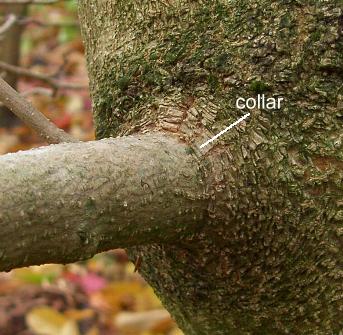Information for homeowners,
garden centre personnel,
and plantscape technicians.

| HOME | SITEMAP | SEARCH | ARTICLES |
|
Indoor Plant Care Information for homeowners, garden centre personnel, and plantscape technicians. |
|
 |
Most gardens only have room to accommodate one or two trees, and even these have to be species which do not grow into large specimens. It is better to prune out some branches when they are small, than to wait until they are an obvious problem. This can save the expense of hiring a specialist contractor and keeps the tree in a naturalistic shape without ugly scars where large branches have been removed.
Stand back from the tree and decide the height where the canopy should begin, then remove any branches below this point. Always make a shallow cut underneath first to prevent a long tail breaking away pulling bark with it.
Now consider the upper canopy and thin out the branches to leave them evenly distributed, cutting close to the origin so that there are no snags left which will die back and could attract diseases such as Coral Spot. If further thinning is required, cut at a fork in a branch, removing the longest growth. Try to avoid stumps by leaving thinner branches to give a softer more natural look.
When removing large branches take off most of the outer growth first to reduce the weight, then cut the main stem about 30cm from the base. The final cut is made close to the origin, cutting underneath about half-way through, then from the top - there is usually a slightly raised collar on the trunk around the base of the branch which defines the line where the cut should be made. Pare off any frayed edges with a sharp knife. If the tree is prone to disease use a wound sealant which contains a fungicide.
Keep standing away from the tree during the process and look over your work to pick the branches to remove. The canopy should be open without too many inward-growing branches or ones which rub against another. If possible catch hold of the target branch and shake it to see the space it is occupying, this will give a clue to how its absence will look.
Cut back to the natural 'collar' which will grow over the wound to seal it.
Trees such as Silver Birch and Maples are usually pruned in late autumn or winter when the sap is down to prevent 'bleeding' from the cuts which would occur if pruned in the spring. Others like Oak or Ash can be pruned up until the buds begin to break. Pruning when the leaves are absent makes it easier to see what you are doing, but there are exceptions. Any of the stoned-fruit trees, eg. cherry, plumb, almond, peach, are prone to a disease called Silver Leaf which enters through wounds, so they are pruned in the summer when the sap is not moving as much and there are fewer spores around. Although this is also when they are still carrying their fruit, removing some of it will improve the remainder and the branches would be missing the next year anyway.
Back to Home Page
or use the floating menu at the top of the page to find other articles.